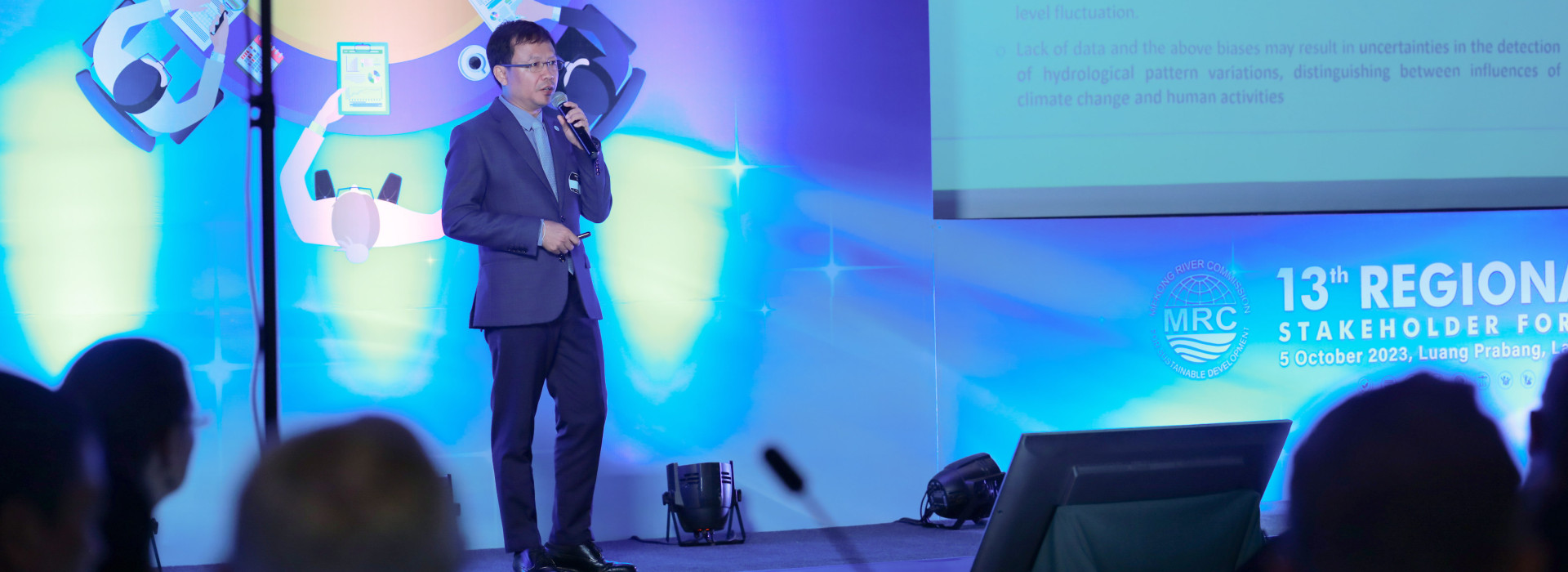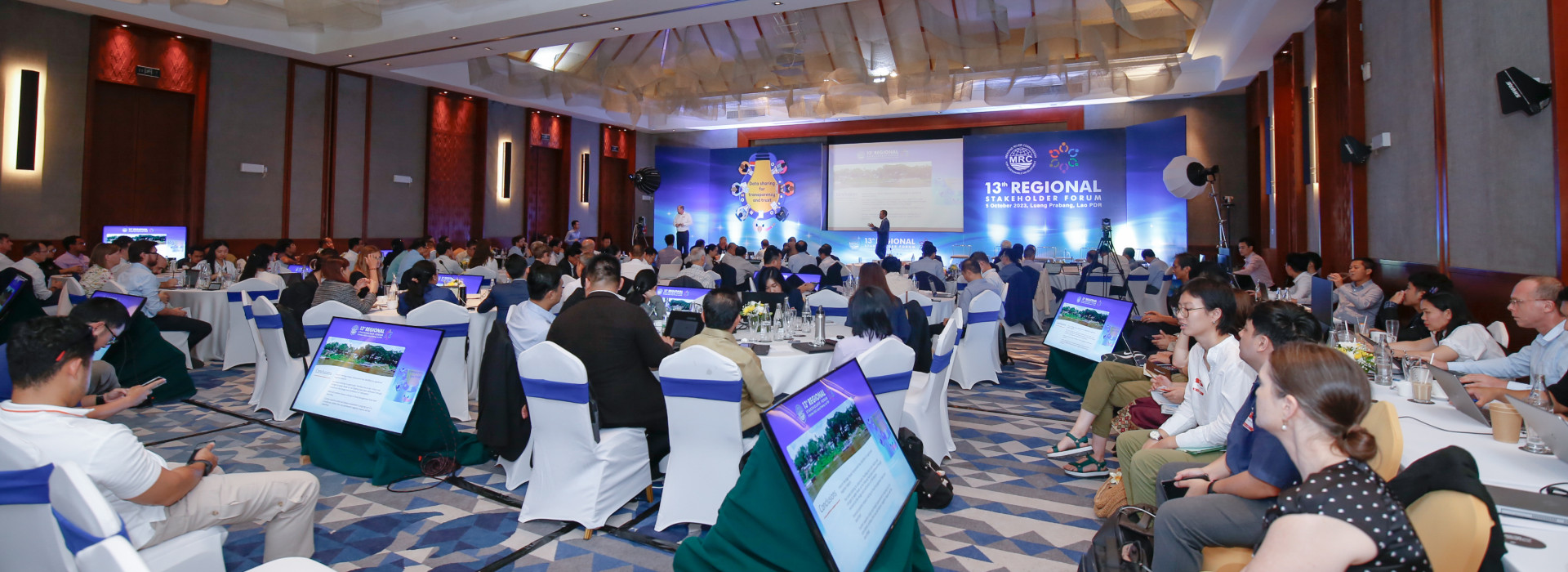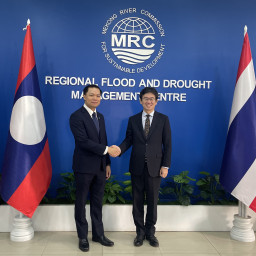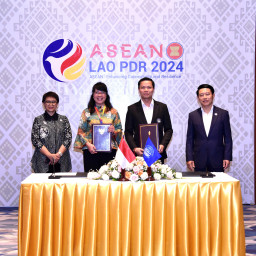New report: Climate, human activities are key causes of Mekong flow changes
Luang Prabang, Lao PDR, 9 October 2023—Climate-caused drought has adversely affected the mighty Mekong River in recent years, from the historic low flows of 2019–2021 to the rare “reverse flow” that has shrunk Cambodia’s vital Tonle Sap Lake, according to the initial findings of a landmark Joint Study released Thursday. Water infrastructure development is also a contributing factor, impacting the natural flow regime with increased dry season flow and reduced flood season flow.
The Joint Study partners – the Mekong River Commission (MRC) and its upstream counterpart, the Lancang-Mekong Water Resources Cooperation Center (LMC Water Center) – presented their Phase 1 findings on Southeast Asia’s most important waterway at the 13th MRC Regional Stakeholders Forum, which was held Thursday, 5 October.
Dr Anoulak Kittikhoun, CEO of the MRC Secretariat, says this Joint Study symbolizes a deepening relationship and trust between the two sides. “It’s the result of an unprecedented level of effort that the MRC and LMC have invested in our existing cooperation,” Kittikhoun said. “Indeed, while we’ve conducted some joint research and studies before, this current effort sets a high bar. It truly shows a great commitment towards future cooperation between our two organizations.”
This fresh report is officially entitled the Joint Study on the Changing Pattern of Hydrological Conditions of the Lancang-Mekong River Basin and Adaptation Strategies. (The Mekong is known in China as the Lancang.) It offers key recommendations, particularly a short-term recommendation that urges the riverine neighbours to further jointly study the different impacts of development and climate change along key parts of their common river, as well as to share critical data – including “real-time sharing of storage levels and hydropower operations.”
According to the report: “Two key factors contribute to hydrological changes in the LMB: natural factors, including precipitation patterns, evaporation rates, soil properties and topography; and human activities, such as infrastructure development, water management, land cover and land-use changes. These two factors interact and influence the amount, timing and water distribution within the Basin.”
The MRC and LMC Water Center agreed to this Joint Study in late 2019, as they expanded upon previous collaboration. As this Phase 1 report notes, “In both 2016 and 2019, joint studies conveyed objective information about the severe droughts to the public and made scientific evaluations of the effects of water supplement from the Lancang reach to alleviate the drought conditions on the Mekong reach.”
Among the most significant passages within this report, it recommends that the Mekong partners enhance notifications of any sudden change in the ways water storage operates: “As global climate change and the associated droughts and floods will play an increasingly important role in driving the basin’s hydrological conditions, it is critical for basin countries to share more information on meteorological flow conditions, extending to tributaries.”
The report continues: “Real-time data on storage levels and hydropower operations is crucial for operational models and adaptive management. Long-term data on tidal changes, water and land use, and Mekong delta groundwater levels support basin-wide research. The information-sharing platform proposed under the LMC cooperation framework provides an unprecedented opportunity.”
For this Joint Study, the two sides split their research into two time periods, when water storage dramatically increased from one period to the other: 2000–2009 when the Lower Mekong River Basin accumulated 20% of its storage; then 2010–2020 when 80% of it was collected – at a time of growing irrigation demands, declining rainfall, and generally drier, drought-induced conditions. While storage increased over time, even today it “amounts to some 27% of the mean annual runoff (MAR) at Stung Treng” in Cambodia, which is low compared with river basins in other drought-prone regions of the world; the Colorado River basin typically holds storage of more than 200% of the MAR. The MRC advocates for more Mekong storage to address future climate change, as well as for the coordinated operation of current storage.
The report also includes a call to action, beyond increased data sharing, with multiple medium-term recommendations that should be driven by “sound science and common understanding.” They include coordinated management of water resources; a comprehensive drought and flood management strategy; more joint studies; and a capacity building plan for water policymakers, managers, engineers, and scientists, addressing knowledge gaps through formal and informal training.”
From here, Phase 2 of this Joint Study will embrace the recommendations, predict future trends in the evolving hydrology, and “propose strategies for the riparian States to adapt to climate and demographic changes” – and continue their support for the Basin’s sustainable management and development.
Note to Editors:
The MRC is an intergovernmental organization established in 1995 to boost regional dialogue and cooperation in the Lower Mekong River Basin. Based on the Mekong Agreement among Cambodia, Lao PDR, Thailand and Viet Nam, the MRC serves as both a regional platform for water diplomacy and a knowledge hub – to manage water resources and support sustainable development of the region.
###








